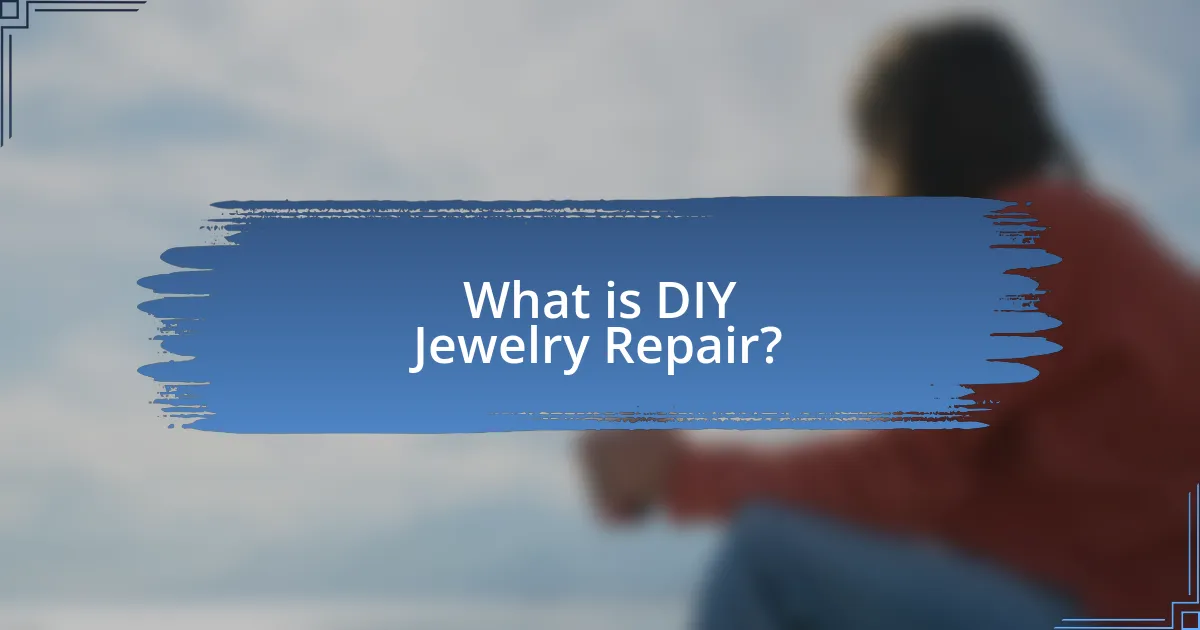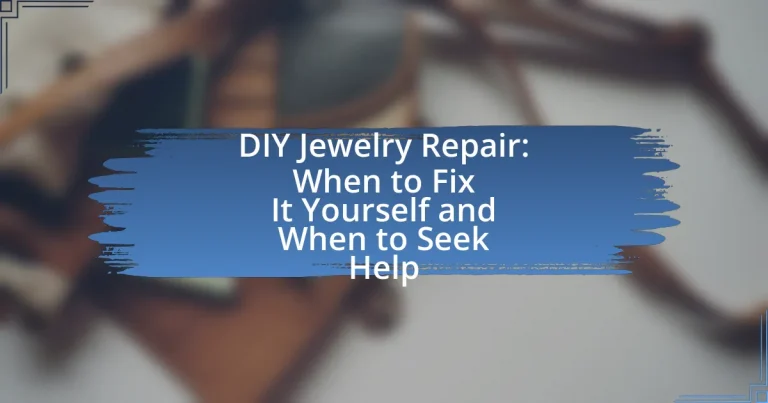DIY jewelry repair involves fixing or restoring jewelry items independently, utilizing basic tools and materials for tasks such as re-stringing necklaces, replacing clasps, and repairing broken chains. This practice not only saves money but also allows for personalization and sustainability by extending the life of jewelry. The article outlines the benefits of DIY repairs, the types of jewelry that can be fixed at home, essential tools needed, and common issues that can be addressed. It also discusses when to seek professional help, the risks associated with DIY repairs, and resources available for learning repair techniques, providing a comprehensive guide for individuals considering jewelry repair on their own.

What is DIY Jewelry Repair?
DIY jewelry repair refers to the process of fixing or restoring jewelry items by oneself, rather than seeking professional assistance. This practice often involves simple tasks such as re-stringing necklaces, replacing clasps, or repairing broken chains, which can be accomplished with basic tools and materials. Many individuals engage in DIY jewelry repair to save money, personalize their pieces, or extend the life of their jewelry. The rise of online tutorials and accessible repair kits has made it easier for people to learn and perform these repairs at home.
How can DIY jewelry repair benefit you?
DIY jewelry repair can benefit you by saving money and allowing for personalized customization. By performing repairs yourself, you eliminate the costs associated with professional services, which can range from $20 to $100 or more depending on the complexity of the repair. Additionally, DIY repair enables you to modify or enhance your jewelry according to your personal style, fostering creativity and satisfaction in the process. This hands-on approach not only empowers you with new skills but also contributes to sustainability by extending the life of your jewelry.
What types of jewelry can be repaired at home?
Common types of jewelry that can be repaired at home include broken chains, loose clasps, and simple earring backs. These repairs often require minimal tools and materials, such as pliers, jump rings, or adhesive. For instance, a broken chain can typically be fixed by reattaching links with pliers, while a loose clasp can be tightened or replaced easily. Additionally, earring backs can often be swapped out without professional assistance. These types of repairs are manageable for individuals with basic DIY skills and can save time and money compared to professional services.
What tools are essential for DIY jewelry repair?
Essential tools for DIY jewelry repair include pliers, wire cutters, a soldering iron, a jewelry saw, and a magnifying glass. Pliers are crucial for gripping and bending wire, while wire cutters are necessary for trimming excess materials. A soldering iron allows for joining metal pieces securely, and a jewelry saw is used for cutting intricate designs or removing broken parts. A magnifying glass aids in detailed work, ensuring precision in repairs. These tools collectively enable effective and efficient jewelry repair, making them indispensable for DIY enthusiasts.
What common jewelry issues can be fixed yourself?
Common jewelry issues that can be fixed yourself include broken chains, loose stones, tarnished metal, and bent or misshapen rings. For broken chains, you can use pliers to reconnect links or replace a clasp. Loose stones can often be secured with a small amount of jewelry adhesive. Tarnished metal can be cleaned using a mixture of baking soda and water or a specialized jewelry cleaner. Bent or misshapen rings can be gently reshaped using your fingers or a ring mandrel. These repairs are manageable with basic tools and materials, making them suitable for DIY fixes.
How do you repair broken chains?
To repair broken chains, first, identify the type of chain and the nature of the break. If the chain is made of metal, use pliers to open the link at the break, then reconnect it by inserting the link back into place and closing it securely. For chains with a clasp, ensure the clasp is functioning properly and reattach it if necessary. If the chain is beaded or made of delicate materials, consider using a needle and thread to re-string the beads or replace any damaged components. Proper tools, such as jewelry pliers and wire cutters, are essential for effective repairs.
What steps are involved in replacing a missing stone?
To replace a missing stone, first, identify the type and size of the stone needed for the replacement. Next, remove any remaining pieces of the old stone or setting using appropriate tools, ensuring not to damage the surrounding area. Then, secure the new stone in place, either by using adhesive or by resetting it into the original setting. Finally, check the stability of the stone and clean the area to restore the jewelry’s appearance. This process is essential for maintaining the integrity and aesthetic of the piece.
When is it appropriate to attempt DIY jewelry repair?
It is appropriate to attempt DIY jewelry repair when the damage is minor and does not require specialized tools or skills. Common situations include replacing a simple clasp, re-stringing beads, or fixing a loose stone in a setting. These tasks can often be completed with basic tools and materials available at craft stores. According to a survey by Jewelers of America, approximately 70% of jewelry repairs can be performed by individuals with basic crafting skills, indicating that many minor repairs are suitable for DIY efforts.
What factors should you consider before starting a repair?
Before starting a repair, you should consider the complexity of the repair task. Complex repairs may require specialized skills or tools that you may not possess, which can lead to further damage or increased costs. Additionally, assess the value of the item; if the jewelry is of significant monetary or sentimental value, it may be wiser to seek professional help to ensure proper restoration. Furthermore, evaluate your own experience and comfort level with similar repairs; lack of experience can result in mistakes that compromise the integrity of the piece. Lastly, consider the availability of replacement parts or materials needed for the repair, as their absence can hinder the repair process.
How do you assess the complexity of the repair needed?
To assess the complexity of the repair needed, evaluate the type of damage, the materials involved, and the tools required. For instance, a simple task like replacing a clasp may require minimal tools and skills, while repairing a broken gemstone setting involves more intricate techniques and specialized tools. The complexity increases with factors such as the jewelry’s design intricacies, the type of metal, and whether the repair requires soldering or other advanced methods. Understanding these elements helps determine if the repair is manageable for a DIY approach or if professional assistance is necessary.

When should you seek professional help for jewelry repair?
You should seek professional help for jewelry repair when the damage is beyond basic fixes, such as broken clasps, loose stones, or significant structural issues. Professional jewelers possess specialized tools and expertise to handle intricate repairs, ensuring the integrity and value of the piece is maintained. For instance, if a gemstone is loose or missing, a jeweler can securely reset it, which requires precision that DIY methods may not achieve. Additionally, if the jewelry is made of precious metals or contains intricate designs, professional repair is advisable to avoid further damage.
What signs indicate that a repair is beyond DIY capabilities?
Signs that indicate a repair is beyond DIY capabilities include the presence of specialized tools or techniques required for the repair, such as soldering or stone setting, which are not typically available to the average person. Additionally, if the damage involves intricate components or delicate materials that could easily be further damaged, it is a clear sign that professional help is needed. For instance, if a piece of jewelry has broken clasps or loose stones that require precise adjustments, attempting to fix it without expertise may lead to more significant issues. Furthermore, if the repair involves valuable or sentimental items, the risk of irreversible damage makes seeking professional assistance advisable.
How can the value of the jewelry affect your decision?
The value of the jewelry significantly influences the decision to repair it yourself or seek professional help. Higher-value jewelry often requires specialized skills and tools for proper repair, making DIY attempts risky and potentially damaging. For instance, a piece valued at over $1,000 may warrant professional repair to preserve its integrity and value, as improper handling could lead to further damage or loss of worth. Conversely, lower-value items may be more suitable for DIY repairs, as the cost of professional services may exceed the item’s worth. Thus, assessing the jewelry’s value is crucial in determining the appropriate course of action for repair.
What types of repairs are best left to professionals?
Repairs involving intricate jewelry settings, such as resetting gemstones or repairing complex mechanisms in watches, are best left to professionals. These types of repairs require specialized tools, expertise, and experience to avoid damaging the item further. For instance, a jeweler has the skills to handle delicate materials and ensure that the integrity of the piece is maintained, which is crucial for valuable items. Additionally, professional jewelers often provide warranties on their work, offering assurance that the repair will be done correctly.
What are the risks of DIY jewelry repair?
The risks of DIY jewelry repair include potential damage to the jewelry, personal injury, and financial loss. When individuals attempt repairs without proper skills or tools, they may inadvertently break delicate components, leading to irreparable damage. Additionally, using inappropriate materials or techniques can result in safety hazards, such as sharp edges or toxic substances. Financially, a poorly executed repair may necessitate professional intervention, which can be more costly than if the repair had been handled by an expert initially. Statistics indicate that over 30% of DIY repairs lead to further damage, emphasizing the importance of assessing one’s capabilities before proceeding with jewelry repairs.
How can improper repairs damage your jewelry?
Improper repairs can damage your jewelry by compromising its structural integrity and aesthetic appeal. For instance, using the wrong adhesive can weaken the bond between components, leading to breakage or loss of stones. Additionally, incorrect resizing can distort the shape of rings, making them uncomfortable or unwearable. According to a study by the Gemological Institute of America, improper handling during repairs can also lead to scratches or other surface damage, diminishing the overall value of the piece.
What are the potential costs of DIY mistakes?
The potential costs of DIY mistakes in jewelry repair can include financial loss, damage to the item, and the need for professional repairs. Financially, incorrect repairs can lead to expenses that exceed the cost of hiring a professional from the outset; for example, a poorly executed fix may require a jeweler to spend additional time and resources to correct the error. Damage to the jewelry itself can occur if improper tools or techniques are used, potentially resulting in irreparable harm to valuable pieces. According to a survey by Jewelers of America, 30% of DIY repairs lead to further damage, highlighting the risks involved.

How to make informed decisions about jewelry repair?
To make informed decisions about jewelry repair, assess the damage and determine whether it requires professional expertise or can be handled as a DIY project. For instance, minor repairs like replacing a clasp or re-stringing beads can often be done at home with basic tools, while complex issues such as resetting a stone or repairing a broken shank typically necessitate a jeweler’s skills. Researching the specific repair needed, consulting online tutorials, and evaluating the cost of professional services versus DIY materials can provide clarity. According to a survey by Jewelers of America, 70% of consumers prefer professional repair for intricate pieces, highlighting the importance of expertise in maintaining jewelry integrity.
What resources are available for learning DIY jewelry repair?
Resources available for learning DIY jewelry repair include online tutorials, instructional videos, and specialized books. Websites like YouTube offer a plethora of video guides that demonstrate various repair techniques, while platforms such as Skillshare and Udemy provide structured courses on jewelry making and repair. Additionally, books like “The Complete Jewelry Repair Manual” by John M. H. Houghton offer comprehensive insights into tools and methods used in jewelry repair. These resources collectively equip individuals with the knowledge and skills necessary for effective DIY jewelry repair.
How can online tutorials enhance your repair skills?
Online tutorials can significantly enhance your repair skills by providing step-by-step guidance and visual demonstrations tailored to various repair tasks. These tutorials often include detailed explanations, tips, and techniques that help learners understand the intricacies of jewelry repair, making complex processes more accessible. For instance, a study by the Pew Research Center found that 73% of adults believe online video platforms are helpful for learning new skills, indicating the effectiveness of visual learning in skill acquisition.
What community resources can provide support?
Community resources that can provide support for DIY jewelry repair include local craft stores, community workshops, and online forums. Local craft stores often offer classes or workshops on jewelry making and repair, providing hands-on guidance and access to tools. Community workshops, such as those found in makerspaces, allow individuals to use equipment and receive mentorship from experienced artisans. Online forums and social media groups dedicated to jewelry repair also serve as valuable platforms for sharing tips, troubleshooting issues, and connecting with others who have similar interests. These resources collectively enhance skills and confidence in DIY jewelry repair.
What are some best practices for DIY jewelry repair?
Best practices for DIY jewelry repair include using the right tools, such as pliers, wire cutters, and a magnifying glass, to ensure precision and safety during repairs. Additionally, cleaning the jewelry thoroughly before starting any repair helps to assess the damage accurately and prevents dirt from interfering with the repair process. It is also crucial to work in a well-lit area to avoid missing small details and to keep a clean workspace to prevent losing tiny components. Following online tutorials or guides specific to the type of jewelry being repaired can provide valuable insights and techniques. Lastly, testing the repair gently before wearing the jewelry ensures that it is secure and functional.
How can you ensure safety while repairing jewelry?
To ensure safety while repairing jewelry, always wear protective gear such as safety goggles and gloves. This minimizes the risk of injury from sharp tools and materials. Additionally, work in a well-lit, organized space to prevent accidents and ensure you can see small components clearly. Using tools designed for jewelry repair, such as pliers and soldering equipment, reduces the likelihood of mishaps. Following these safety measures is crucial, as jewelry repair often involves small parts and potentially hazardous materials, making safety a top priority.
What tips can help you achieve professional-looking results?
To achieve professional-looking results in DIY jewelry repair, focus on using high-quality tools and materials. High-quality tools, such as precision pliers and soldering equipment, ensure accuracy and durability in repairs. Additionally, selecting appropriate materials, like matching metal types and finishes, enhances the overall appearance and longevity of the jewelry. Proper lighting and a clean workspace also contribute to better visibility and precision during the repair process, leading to more polished results.
What troubleshooting tips can assist in DIY jewelry repair?
To assist in DIY jewelry repair, start by identifying the specific issue, such as a broken clasp or a loose stone. Once the problem is identified, gather the necessary tools, including pliers, wire cutters, and adhesive, to facilitate the repair process. For instance, if a chain is broken, use pliers to open and close jump rings securely. Additionally, ensure that you work in a well-lit area to avoid losing small components. According to jewelry repair experts, maintaining a clean workspace can significantly reduce the risk of misplacing parts during repairs.


